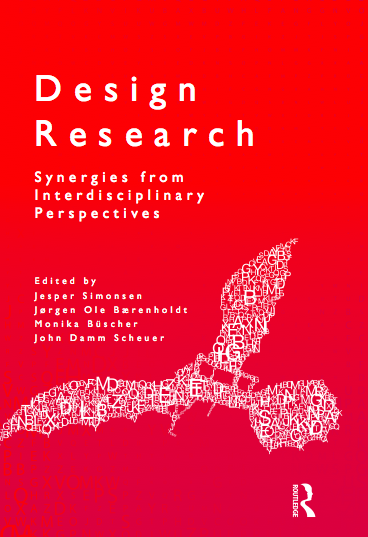Information about the book from Routledge
Description, table of contents, author information and order form
Preface
Information about the book from Routledge
Description, table of contents, author information and order form![]()

Design Research is a new interdisciplinary research area with a social science orientation at its heart, and this book explores how scientific knowledge can be put into practice in ways that are at once ethical, creative, helpful, and extraordinary in their results.
In order to clarify the common aspects – in terms of features and approaches – that characterize all strands of research disciplines addressing design, Design Research undertakes an in depth exploration of the social processes involved in doing design, as well as analyses of the contexts for design use. The book further elicits ‘synergies from interdisciplinary perspectives’ by discussing and elaborating on differing academic perspectives, theoretical backgrounds, and design concept definitions, and evaluating their unique contribution to a general core of design research.
This book is an exciting contribution to this little explored field, and offers a truly interdisciplinary approach to the treatment of design and the design process. It is valuable reading for students in disciplines such as design studies and theory, participatory design, informatics, arts based education, planning, sociology and interdisciplinary programmes for example in humanities and technology.
Preface
This book is the result of ongoing discussions between interdisciplinary design researchers. The discussions were initiated among researchers at Roskilde University in 2007 when the university opened a new subject area within design studies, combining humanistic, technological, and social science perspectives to develop students’ competence to engage with complex design problems. Roskilde University is known for its interdisciplinary and design oriented approach to research and teaching. Moreover, a tradition of interdisciplinary problem oriented project work aimed at solving practical problems in the ‘real world’ has existed since the university was established in 1972 as an alternative to more traditional and mono-disciplinary universities.
A series of workshops was arranged between researchers from different areas of design research, including business and organizational studies, urban planning, computer science and informatics, geography, health, performance design. We quickly realized that we shared interdisciplinary perspectives on the emerging field of design research and discovered a need for more research into interdisciplinary approaches to enable design that is robust by appreciating the realities and dynamic complexities of its context.
The idea of investigating synergies between our own forms of design research culminated in a conference discussing nine paper contributions (some of which later formed input to chapters of this book) on the theme ‘Perspectives on Practice-Oriented Design Science’, held in spring, 2008. The proposal for this book was made after this conference, in collaboration with design researchers from Lancaster University, which is also famous for its interdisciplinary and design oriented programs. The team of contributors finally comprised 23 authors from Roskilde University, Lancaster University, University of Montreal, University of Aarhus, Georgia State University, Copenhagen University, and The Danish Design School.
Our discussions have focused on how our interdisciplinary design research knowledge is put into practice, and on which common aspects and approaches characterize our different ways of addressing design research. To develop synergies, all contributors met at an international workshop held in Denmark in August 2009, funded by Roskilde University where authors peer-reviewed and discussed draft chapters. Over two days, we discussed and elaborated our different perspectives, discovered and nurtured synergies, and identified core aspects of our interdisciplinary design research. The results from the workshop were subsequently analyzed by the editors using a grounded theory approach and are presented in the concluding chapter 14: Synergies.
As editors we have immensely enjoyed our numerous conversations and exchanges of draft materials with the authors in this book. We hope that you will enjoy reading the book and participate in the discussions that it raises. During fall 2009, we had the opportunity to test a draft of the book in an advanced graduate course and experienced how the chapters opened up deep and relevant discussions among students and their supervisors.
Finally, we would like to thank Roskilde University’s Rector for funding the international workshop, and our departments colleagues for their support. To work with the enthusiastic and competent staff at Routledge has been a pleasure. Making this book was a rewarding experience of iterative and emergent collaborative design, challenging, enriching and joyful!
Roskilde University and Lancaster University, December 2009
Jesper Simonsen, Jørgen Ole Bærenholdt, Monika Büscher, and John Damm Scheuer
See also the following chapters from the book:
6.10: Simonsen, J., J.O Bærenholdt, J.D. Scheuer, and M. Büscher (2010): "Synergies", in Simonsen, J., J.O Bærenholdt, M. Büscher, and J.D. Scheuer (Eds.) Design Research: Synergies from Interdisciplinary Perspectives, Routledge, pp. 201-212.
Introduction
6.9: Simonsen, J. and M. Hertzum (2010): "Iterative Particpatory Design", in Simonsen, J., J.O Bærenholdt, M. Büscher, and J.D. Scheuer (Eds.) Design Research: Synergies from Interdisciplinary Perspectives, Routledge, pp. 16-32.
Abstract
6.8: Bærenholdt, J.O., M. Büscher, J.D. Scheuer, and J. Simonsen (2010): "Perspectives on Design Research", in Simonsen, J., J.O Bærenholdt, M. Büscher, and J.D. Scheuer (Eds.) Design Research: Synergies from Interdisciplinary Perspectives, Routledge, pp. 1-15.